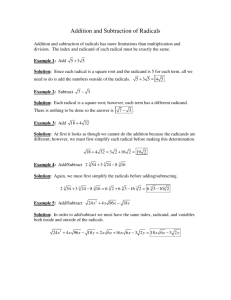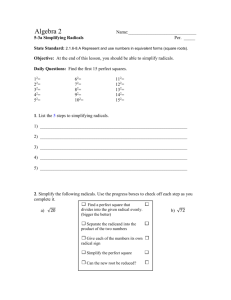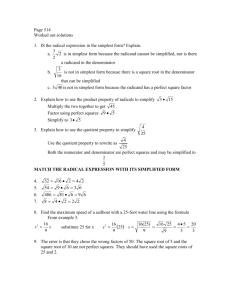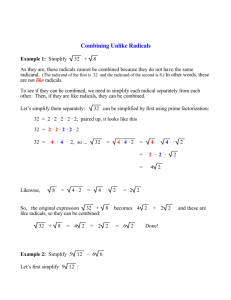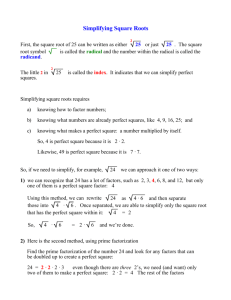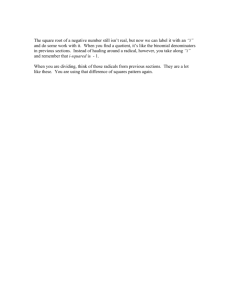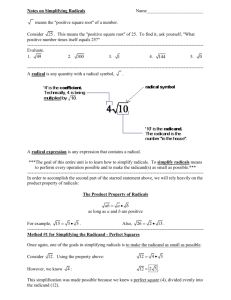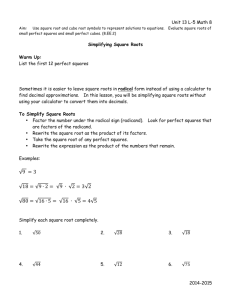Simplifying and Multiplying Radicals
advertisement
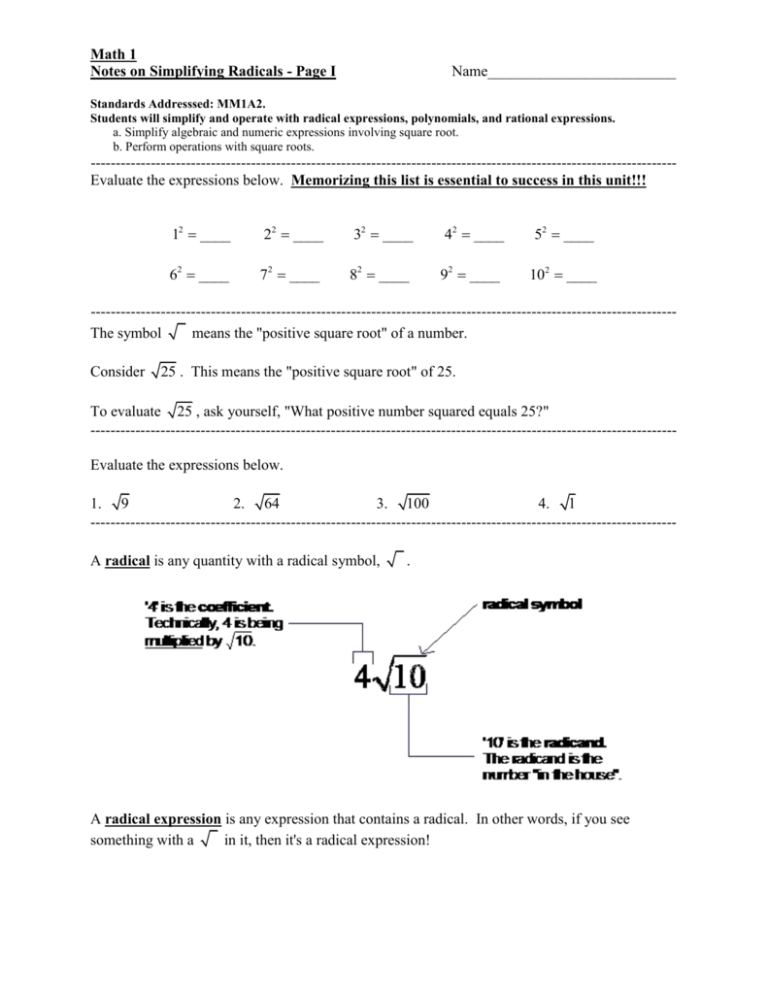
Math 1 Notes on Simplifying Radicals - Page I Name_________________________ Standards Addresssed: MM1A2. Students will simplify and operate with radical expressions, polynomials, and rational expressions. a. Simplify algebraic and numeric expressions involving square root. b. Perform operations with square roots. --------------------------------------------------------------------------------------------------------------------Evaluate the expressions below. Memorizing this list is essential to success in this unit!!! 12 ____ 22 ____ 32 ____ 42 ____ 52 ____ 62 ____ 72 ____ 82 ____ 92 ____ 102 ____ --------------------------------------------------------------------------------------------------------------------The symbol means the "positive square root" of a number. Consider 25 . This means the "positive square root" of 25. To evaluate 25 , ask yourself, "What positive number squared equals 25?" --------------------------------------------------------------------------------------------------------------------Evaluate the expressions below. 1. 9 2. 64 3. 100 4. 1 --------------------------------------------------------------------------------------------------------------------A radical is any quantity with a radical symbol, . A radical expression is any expression that contains a radical. In other words, if you see something with a in it, then it's a radical expression! For example, Evaluate 4 9 is a radical expression. 4 9 by first evaluating the square roots and then multiplying the results. So, recapping the bottom of the front side, 4 9 = __________. Suppose one multiplied the radicands (the numbers in the house) first, and then found the square root of that. Would he/she get the same result? 4 9 36 ____________. Yes! The result is the same. --------------------------------------------------------------------------------------------------------------------Let's see if this works for a similar radical expression. Evaluate the expression on the left by finding the square roots first. Evaluate the expression on the right by multiplying the radicands first. 25 4 25 4 --------------------------------------------------------------------------------------------------------------------The point of the previous exercise is to show you the product property of radicals. The Product Property of Radicals If a and b are positive numbers, then a b ab or ab a b For example, consider 8100 . Without a calculator, this may seem intimidating. However, which perfect square on the front side of the paper do you think divides evenly in 8100? Therefore, 8100 = ____ ____ ______ . --------------------------------------------------------------------------------------------------------------------Some radicands are not perfect squares. For example, try to evaluate 12 in your calculator, and you will get a messy decimal that continues forever...off of the calculator screen. We never ever want to try to write this number because it is impossible to do so. Instead, the goal will be to make the radicand as small as possible. This is the primary goal of a process known as simplifying radicals. Which perfect square on the front side of the paper divides evenly into 12? Thus, 12 = __________. Notes on Simplifying Radicals - Page II Name_________________________ Important - you must always check to make sure that no other perfect squares can divide evenly into the radicand of your answer. Again, the goal is to make the radicand as small as possible. --------------------------------------------------------------------------------------------------------------------Again, here is a list of some perfect squares: 4, 9, 16, 25, 36, 49, 64, 81, 100. Simplify 150 . Since 25 is a perfect square that divides evenly into 150, the expression can be rewritten as = ___________. 150 25 --------------------------------------------------------------------------------------------------------------------It is possible that no perfect squares will divide evenly into the radicand. If this is the case, then it is possible that the expression cannot be simplified. For example, consider 17 . Since none of the perfect squares above divide evenly into 17, 17 cannot be simplified. --------------------------------------------------------------------------------------------------------------------For Questions 5-8, simplify completely. 5. 18 6. 40 7. 108 8. 3 50 --------------------------------------------------------------------------------------------------------------------How to Multiply Radicals 1)Multiply the coefficients and the radicands separately (do not cross the streams!!!). 2)Simplify the radicand at the end. For example, consider 3 2 4 5 . As we have learned, multiplication is commutative. So, the order can technically be changed to be 3 4 2 5 . Now, the numbers on the outside are next to each other, and square roots are next to each other. Multiply "3 and 4", and multiply "2 and 5" to get 12 10 . The radicand, 10, cannot be simplified any more, so 12 10 is the final answer. --------------------------------------------------------------------------------------------------------------------Simplify completely. 9. 2 4 3 10. 9 2 5 6 11. (4 3)(8 15)(2 2) Homework on Simplifying & Multiplying Radicals Name_________________________ Simplify. If the expression cannot be simplified, write cannot be simplified. 1. 24 2. 45 3. 81 4. 34 5. 27 6. 48 7. 2 80 8. 3 9 9. 10 96 10. 72 11. 144 12. 4 42 13. 2 256 14. 400 15. 5 125 16. 210 18. 2 7 21. 2 10 2 24. (3 6)(9 2)(4 10) 17. 19. 1000 20. 100 5 2 6 3 6 22. 4 8 6 4 23. 8 3 2 25. 7 4 49 --------------------------------------------------------------------------------------------------------------------1. 2 6 2. 3 5 3. 9 4. cannot be simplified 5. 3 3 6. 4 3 7. 8 5 8. 9 9. 40 6 10. 6 2 11. 12 12. cannot be simplified 13. 32 14. 20 15. 25 5 16. cannot be simplified 17. 10 10 18. 14 19. 3 2 20. 200 30 21. 2 20 4 5 24. 108 120 216 30 22. 24 32 96 2 23. 24 2 25. 4 343 28 7
